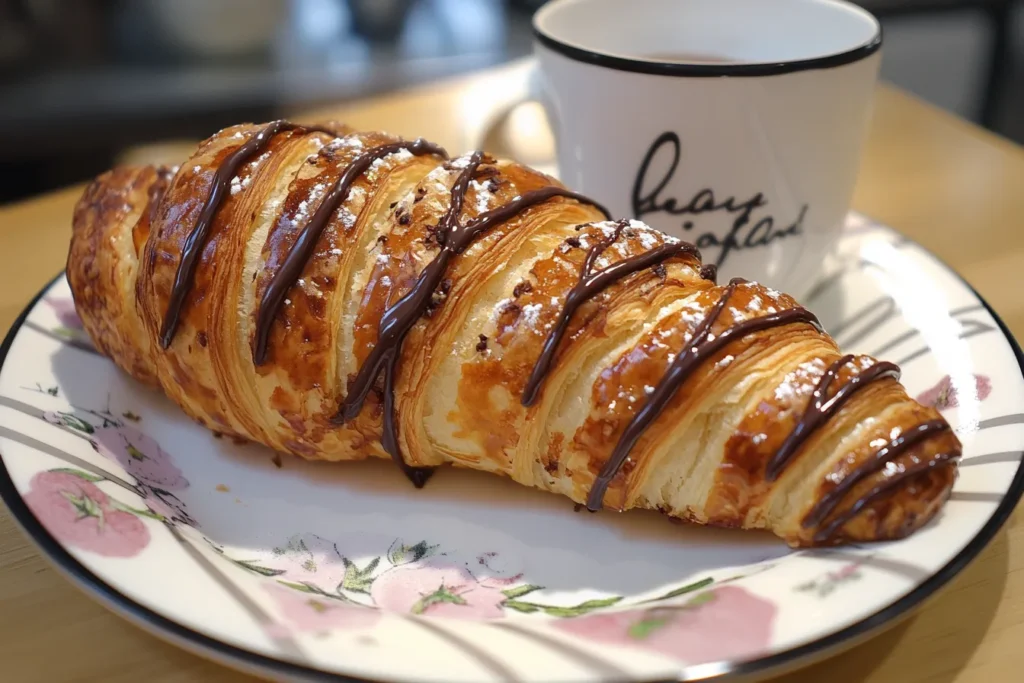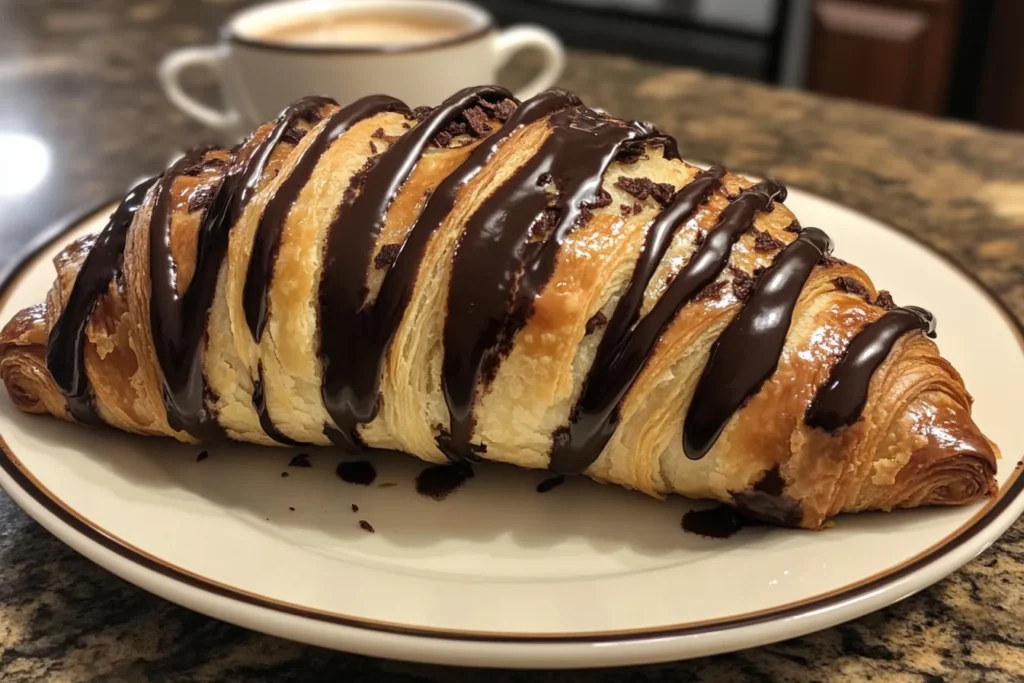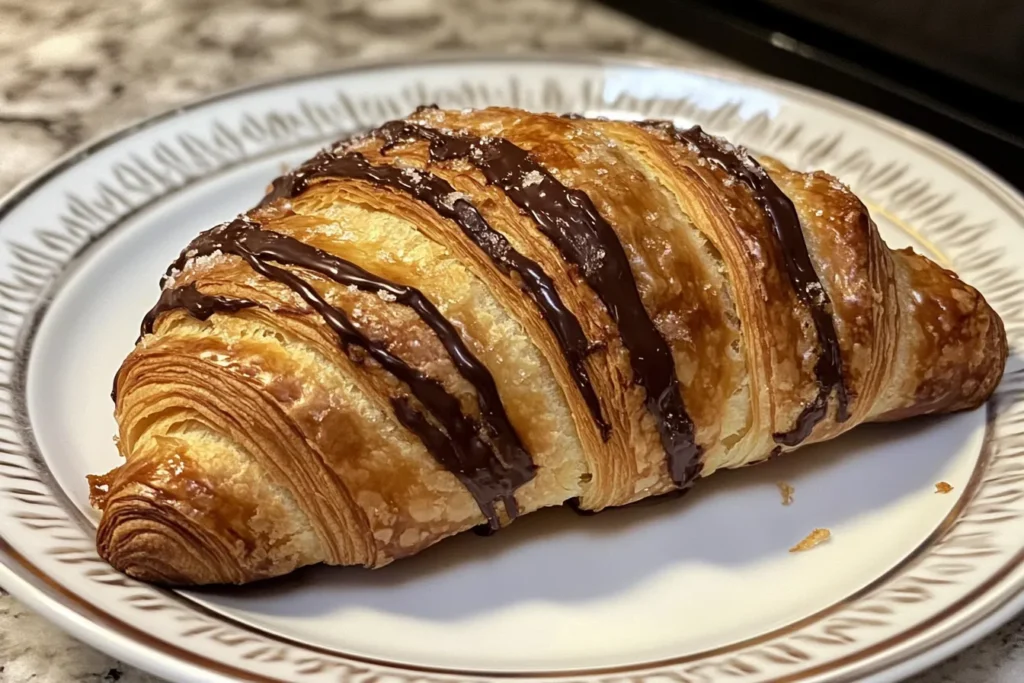Have you ever stood in front of a bakery counter, staring at a chocolate croissant and a pain au chocolat, wondering if they’re actually the same thing? You’re not alone—this is a common question for pastry lovers everywhere. Both are buttery, flaky, and filled with delicious chocolate, but the difference lies in their shape, name, and sometimes even the recipe. If you’ve ever felt a little confused trying to figure out which one to order (or bake), don’t worry—I’ve been there too. Let’s break it down so you can confidently choose the perfect pastry the next time your sweet tooth strikes!
List Of Contents
Overview of Chocolate Croissant and Pain au Chocolat
Defining Both Pastries
The chocolate croissant features a crescent shape, crafted from buttery, flaky dough and filled with a sweet strip of chocolate. Its distinct shape, resembling a moon crescent, makes it instantly recognizable.
On the other hand, bakers craft pain au chocolat as a rectangular pastry using laminated dough, folding it around one or two bars of dark chocolate. Its structure is neat and compact, emphasizing functionality over flair. Check out more recipes here.
Why the Confusion Between the Two Exists
Regional naming conventions and overlapping ingredients mainly cause the confusion. In many English-speaking countries, people often refer to pain au chocolat as a “chocolate croissant,” despite its rectangular shape. This mislabeling arises from the shared use of butter-laminated dough, which gives both pastries their airy texture and golden crust.
Additionally, their common chocolate filling and similar baking methods deepen the misunderstanding. Sure! Provide the sentences in passive voice, and I’ll convert them to active voice for you. Check out more recipes here.
Shared Characteristics
Ingredients Used in Both Pastries
At their core, both pastries use a buttery, laminated dough created by folding and rolling butter into the dough to form thin, flaky layers. The key ingredients are:
- Flour
- Butter
- Milk
- Sugar
- Yeast
The chocolate filling is usually high-quality dark chocolate, chosen for its ability to balance the richness of the buttery dough with a slightly bitter flavor profile. Check out more recipes here.
Similarities in Baking Techniques

Achieving the signature flakiness and rich golden color of both pastries demands meticulous baking techniques. Key steps include:
- Lamination: Alternating layers of dough and butter, repeated to build the characteristic layers.
- Proofing: Allowing the pastries to rise, ensuring lightness and an airy texture.
- Baking: High-temperature baking that produces a crispy exterior while maintaining a tender crumb inside.
These shared methods highlight the artistry and patience involved in crafting traditional French pastries. Check out more recipes here.
Cultural Significance of Chocolate Pastries
The Place of Chocolate Croissant in Global Culture
The chocolate croissant has become a symbol of luxury and indulgence. Its crescent shape has an iconic appeal, making it a popular choice in cafés and bakeries around the world. In the United States, people often associate it with a leisurely breakfast or brunch, pairing it with coffee or tea.
Its versatility lets people enjoy it at any time of day, cementing its status as a global favorite. The pastry’s buttery richness and chocolate center strike a balance that appeals to both adults and children. Check out more recipes here.
Pain au Chocolat as a Staple of French Cuisine
In France, pain au chocolat is a staple of breakfast culture, widely available in bakeries and pastry shops. Its compact design makes it easy to enjoy on the go, often accompanied by a café au lait.
This pastry also holds a nostalgic value for many, evoking childhood memories of after-school treats or leisurely Sunday mornings. Its cultural importance extends beyond food; it symbolizes the French dedication to craftsmanship and quality in culinary arts.
Historical Background
Origins of the Chocolate Croissant
The chocolate croissant traces its origins back to the kipferl, a crescent-shaped pastry from Austria. The French adopted the shape and incorporated their love for laminated dough, creating the croissant. Adding chocolate was a later innovation, blending two indulgent components into one irresistible treat.
The History of Pain au Chocolat
Unlike the chocolate croissant, pain au chocolat has a purely French origin. Bakers developed it during the 19th century by wrapping chocolate bars in laminated dough.. Its straightforward design and functional shape reflect its intent as a portable, energy-rich snack.
Today, the debate over its name—pain au chocolat vs. chocolatine—further underscores its deep cultural ties to France.
Key Differences Between Chocolate Croissant and Pain au Chocolat
Despite their shared ingredients and cultural significance, chocolate croissants and pain au chocolat stand apart in numerous ways. From their shape and recipe to regional preferences and naming conventions, these differences highlight the uniqueness of each pastry.
Shape and Appearance
The Crescent Shape of a Chocolate Croissant
The most distinctive feature of the chocolate croissant is its crescent shape. This design is a nod to the croissant’s Austrian roots, inspired by the kipferl. The crescent shape not only enhances its appearance but also influences how bakers layer and bake the dough.
IIn a chocolate croissant, bakers carefully wrap the chocolate filling into the crescent, ensuring even distribution while preserving its iconic silhouette. This shape requires meticulous rolling and folding techniques to achieve a balance between form and function.
The Rectangular Form of Pain au Chocolat
In contrast, pain au chocolat is rectangular, with clean edges and a uniform structure. Bakers fold the dough tightly around one or two chocolate bars, creating a compact shape that highlights portability and practicality..
The rectangular form allows bakers to evenly enclose the chocolate within the layers, ensuring a consistent bite every time. This structured design reflects its role as a staple of French bakeries, where efficiency and elegance converge.
Recipe Variations
Different Lamination Processes
While both pastries use laminated dough, slight variations in the lamination process can influence the final texture and appearance:
- Chocolate croissant: The crescent shape necessitates a more delicate rolling process, which can lead to slightly thinner layers and a lighter, more open crumb.
- Pain au chocolat: Its rectangular form allows for tighter folds, resulting in a denser, more uniform layering of dough and butter.
These differences in lamination are subtle but significant, affecting the pastries’ texture and overall eating experience.
Chocolate Distribution Within Each Pastry
The placement of chocolate also varies:
- IIn a chocolate croissant, bakers spread the filling along the curve, ensuring the chocolate complements the buttery layers.
- In pain au chocolat, bakers place the chocolate bars strategically in parallel lines within the folds, creating a concentrated center of richness.
This distinction contributes to unique flavor profiles, with chocolate croissants offering a more dispersed sweetness and pain au chocolat delivering bold chocolate intensity.
Regional Preferences

Popularity of Chocolate Croissant in International Settings
The chocolate croissant has a universal appeal, often seen as a symbol of French sophistication. In many countries, especially in North America and Asia, it’s marketed as a luxurious treat and a hallmark of French-inspired bakeries.
Its crescent shape is easily recognizable, making it a go-to choice for those seeking a classic yet indulgent pastry. Many cafés worldwide have adopted the chocolate croissant as a staple of their menu, pairing it with specialty coffees or teas.
Pain au Chocolat’s Dominance in French-Speaking Regions
In French-speaking regions, pain au chocolat reigns supreme. Its straightforward design and rich flavor make it a favorite among locals. People often prefer the pastry for its practicality, as its compact shape makes it easy to carry and enjoy.
Moreover, the ongoing debate over its name—pain au chocolat vs. chocolatine—underscores its deep cultural roots. While Parisians favor the traditional term, regions like Aquitaine and Occitanie embrace the term “chocolatine,” reflecting France’s diverse linguistic heritage.
Terminology and Naming Conventions
Why Some Countries Call Pain au Chocolat “Chocolate Croissant”
The confusion surrounding the names stems largely from linguistic and cultural differences. In English-speaking countries, people often use “chocolate croissant” as a catch-all term for any pastry with chocolate and laminated dough. This broad interpretation has caused pain au chocolat to be incorrectly labeled as a croissant variant.
This misnomer persists due to the pastries’ shared traits, despite their distinct shapes and histories. For non-French speakers, simplifying terminology makes these delicacies more accessible.
Linguistic and Cultural Factors Influencing the Names
In France, strict culinary traditions ensure clear distinctions between pain au chocolat and croissants. However, international interpretations often blur these lines. Cultural perceptions of French pastries as luxurious and indulgent contribute to the interchangeable use of names.
In regions where French influence is less pronounced, the term “chocolate croissant” often dominates, blending convenience with a nod to its origins.
Taste, Texture, and Culinary Experiences
The essence of any pastry lies in its flavor and texture, and the chocolate croissant and pain au chocolat deliver distinct experiences. From their taste profiles to their culinary uses, these pastries reflect the artistry and attention to detail that defines French baking.
Taste Profile
Differences in Butteriness and Chocolate Intensity
The primary difference in taste between a chocolate croissant and pain au chocolat lies in the balance of butteriness and chocolate:
- Chocolate Croissant: The crescent shape and slightly thinner layers allow the buttery flavor to dominate. The chocolate is evenly distributed, providing subtle sweetness without overpowering the richness of the dough.
- Pain au Chocolat: With its compact structure, pain au chocolat emphasizes the intensity of the chocolate filling. The denser layers of dough create a harmonious contrast, making each bite deeply satisfying.
Both pastries offer a decadent experience, but the balance between buttery richness and chocolate intensity varies, catering to different preferences.
How Shape Affects Flavor Distribution
The shape of each pastry significantly influences how flavors unfold:
- In a chocolate croissant, the crescent design ensures that the buttery layers surround the chocolate, creating a lighter, more balanced flavor.
- For pain au chocolat, the rectangular form concentrates the chocolate in the center, delivering a burst of flavor with every bite.
This structural difference highlights the importance of design in crafting a unique tasting experience.
Texture Variations

The Flakiness of the Chocolate Croissant
The hallmark of a chocolate croissant is its flaky texture. Achieving this requires precision during the lamination process, where multiple layers of butter and dough are folded and rolled. The result is a light, airy pastry with a crispy exterior that shatters delicately when bitten.
This flakiness adds to the sensory appeal, making it a favorite for those who enjoy a melt-in-your-mouth experience.
The Denser Layers of Pain au Chocolat
In contrast, pain au chocolat boasts a slightly denser texture. Its compact design allows for tighter folds, creating a pastry that is sturdy yet tender. The layers are still buttery and soft, but with a more pronounced chewiness that complements the rich chocolate filling.
This texture makes pain au chocolat ideal for on-the-go consumption, as it holds its shape better than the delicate croissant.
Culinary Uses and Pairings
Chocolate Croissant as a Breakfast Option
The chocolate croissant is synonymous with leisurely breakfasts and indulgent brunches. Its light texture pairs beautifully with a cup of coffee or tea, making it a popular choice for morning meals. The balance of buttery dough and chocolate filling provides just enough sweetness to start the day on a delightful note.
For those seeking variety, the chocolate croissant can also be paired with:
- Fresh fruit for a refreshing contrast.
- Yogurt or granola for added texture and flavor.
Pain au Chocolat in French Bakeries
In French bakeries, pain au chocolat is a quintessential item, enjoyed at any time of day. Its compact design makes it a convenient snack, often consumed with a glass of milk or a café au lait.
The pastry’s sturdier texture also makes it suitable for dipping into beverages, enhancing its flavor and creating a comforting culinary ritual. Its versatility ensures it remains a staple of French gastronomy.
Baking and Presentation
Typical Baking Processes for Chocolate Croissants
The preparation of a chocolate croissant involves:
- Lamination: Folding butter into the dough multiple times to create thin, flaky layers.
- Shaping: Cutting the dough into triangular pieces and rolling them into crescents, with chocolate incorporated during the rolling process.
- Proofing: Allowing the pastries to rise, ensuring a light, airy texture.
- Baking: High-temperature baking to achieve a golden, crispy exterior.
The final product is often glazed with an egg wash for shine, making it visually appealing.
How Pain au Chocolat is Traditionally Made
The process for pain au chocolat is similar but varies slightly due to its shape:
- Lamination: The dough is folded and rolled to create a sturdy, layered structure.
- Shaping: The dough is cut into rectangles, with chocolate bars placed at the center before folding the edges over.
- Proofing: The pastries are allowed to rise, creating a tender crumb.
- Baking: A shorter bake time at high heat ensures a golden crust and a soft interior.
The result is a neatly packaged pastry, perfect for showcasing the richness of the chocolate filling.
Final Comparison
Which Pastry Suits Different Occasions?
The choice between a chocolate croissant and pain au chocolat often depends on the occasion:
- Chocolate Croissant: Best for leisurely meals or as a centerpiece in a pastry spread. Its light texture and elegant shape make it a sophisticated option for brunches or celebrations.
- Pain au Chocolat: Ideal for quick snacks or on-the-go consumption. Its compact design and bold flavor make it a practical yet indulgent choice for everyday enjoyment.
The Debate: Are They Interchangeable?
While the two pastries share similarities, they are not entirely interchangeable. The differences in shape, texture, and flavor create unique experiences that cater to different preferences. Whether you crave the flakiness of a chocolate croissant or the chocolate-forward richness of pain au chocolat, both pastries have their place in the world of French baking.
FAQs
- What’s the main difference between a chocolate croissant and pain au chocolat?
The primary difference is the shape: a crescent for the croissant and a rectangle for pain au chocolat. - Why is pain au chocolat sometimes called a “chocolate croissant”?
Mislabeling in non-French-speaking regions often leads to this confusion. - Which pastry has more chocolate?
Pain au chocolat usually has a more concentrated chocolate filling. - Can these pastries be made at home?
Yes, though mastering laminated dough can be challenging. - What type of chocolate is used in these pastries?
High-quality dark chocolate is typically used. - Are these pastries suitable for vegans?
Traditional recipes are not, but vegan versions using plant-based butter and chocolate are available. - Which pastry is more popular in France?
Pain au chocolat is more commonly consumed in France. - How long do these pastries stay fresh?
They are best enjoyed fresh but can be stored for 1-2 days. - What’s the caloric difference between the two?
The calorie count varies depending on size and recipe, but both are calorie-dense due to the butter and chocolate. - Can they be frozen for later use?
Yes, both pastries freeze well and can be reheated for freshness.
